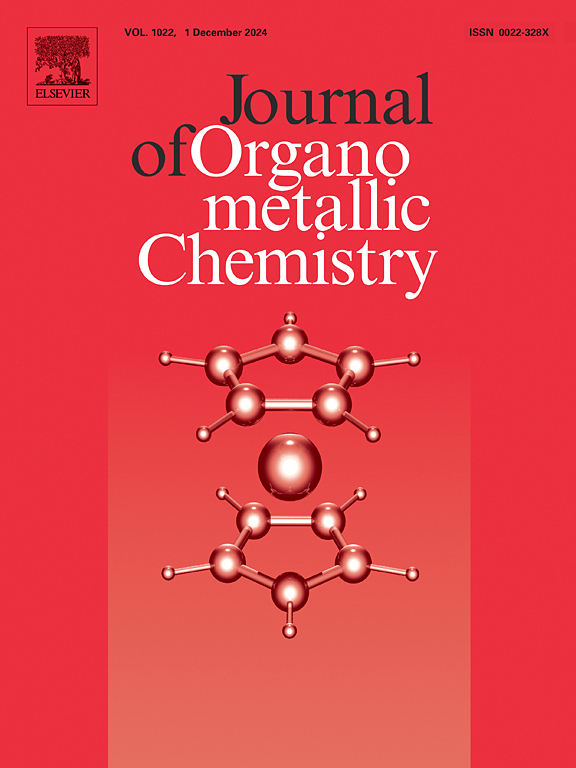Bimetallic nickel-cobalt Ziegler Natta catalyst for hydrogenation of styrene-isoprene copolymer
IF 2.1
3区 化学
Q3 CHEMISTRY, INORGANIC & NUCLEAR
引用次数: 0
Abstract
A series of homogeneous Ziegler-Natta catalysts centered on Ni and Co were prepared and applied for catalytic hydrogenation of Styrene-isoprene block copolymers (SI) with different block ratios to synthesize hydrogenated styrene-isoprene block copolymer (SEP). The dispersion of metal nanoparticles in Ni-Co bimetallic Ziegler catalyst was investigated by TEM, which indicated that when n(Ni): n(Co)=1:1, the dispersion of catalyst nanoparticles was better. Changes in hydrogenation activity and molecular structure of Styrene-isoprene block copolymers (SI) with different block ratios were systematically investigated by nuclear magnetic resonance (1H NMR) and Fourier transform infrared (FT-IR) characterization. Physicochemical properties of Styrene-isoprene block copolymers (SI) and hydrogenated styrene-isoprene block copolymer (SEP) were analyzed by thermogravimetric analysis (TGA), gel permeation chromatography (GPC), swept-surface differential scanning calorimetry (DSC), mechanical tests and UV anti-aging tests. Several new hydrogenated styrene-isoprene (SEP) materials with excellent performance were developed. The relationship between the dispersion of bimetallic active center and hydrogenation activity was investigated, and the hydrogenation mechanism was elaborated. Response surface analysis (RSM) experimental design was made. The effects of hydrogenation pressure, reaction temperature and batch reactor time on the catalytic hydrogenation process were investigated, and the results were consistent with those of RSM. The kinetics of gas-liquid two-phase hydrogenation was also investigated, and the activation energy Ea of the reaction was determined to be 9.394 KJ/mol. The continuous tubular hydrogenation styrene-isoprene block copolymers were explored.

苯乙烯-异戊二烯共聚物加氢用双金属镍钴齐格勒-纳塔催化剂
制备了一系列以Ni和Co为中心的均相Ziegler-Natta催化剂,并应用于不同嵌段比的苯乙烯-异戊二烯嵌段共聚物(SI)的催化加氢合成加氢苯乙烯-异戊二烯嵌段共聚物(SEP)。用TEM研究了金属纳米粒子在Ni-Co双金属齐格勒催化剂中的分散情况,结果表明,当n(Ni): n(Co)=1:1时,催化剂纳米粒子的分散效果较好。采用核磁共振(1H NMR)和傅里叶变换红外(FT-IR)表征系统地研究了不同嵌段比的苯乙烯-异戊二烯嵌段共聚物(SI)的加氢活性和分子结构的变化。采用热重分析(TGA)、凝胶渗透色谱(GPC)、扫描表面差示扫描量热法(DSC)、力学性能测试和紫外线抗老化测试等方法对苯乙烯-异戊二烯嵌段共聚物(SI)和氢化苯乙烯-异戊二烯嵌段共聚物(SEP)的理化性质进行了分析。研制了几种性能优良的新型氢化苯乙烯-异戊二烯(SEP)材料。研究了双金属活性中心的分散与加氢活性的关系,并对加氢机理进行了阐述。进行了响应面分析(RSM)试验设计。考察了加氢压力、反应温度和间歇反应时间对催化加氢过程的影响,结果与RSM一致。研究了气液两相加氢反应的动力学,确定了反应的活化能Ea为9.394 KJ/mol。对连续管式加氢苯乙烯-异戊二烯嵌段共聚物进行了研究。
本文章由计算机程序翻译,如有差异,请以英文原文为准。
求助全文
约1分钟内获得全文
求助全文
来源期刊

Journal of Organometallic Chemistry
化学-无机化学与核化学
CiteScore
4.40
自引率
8.70%
发文量
221
审稿时长
36 days
期刊介绍:
The Journal of Organometallic Chemistry targets original papers dealing with theoretical aspects, structural chemistry, synthesis, physical and chemical properties (including reaction mechanisms), and practical applications of organometallic compounds.
Organometallic compounds are defined as compounds that contain metal - carbon bonds. The term metal includes all alkali and alkaline earth metals, all transition metals and the lanthanides and actinides in the Periodic Table. Metalloids including the elements in Group 13 and the heavier members of the Groups 14 - 16 are also included. The term chemistry includes syntheses, characterizations and reaction chemistry of all such compounds. Research reports based on use of organometallic complexes in bioorganometallic chemistry, medicine, material sciences, homogeneous catalysis and energy conversion are also welcome.
The scope of the journal has been enlarged to encompass important research on organometallic complexes in bioorganometallic chemistry and material sciences, and of heavier main group elements in organometallic chemistry. The journal also publishes review articles, short communications and notes.
 求助内容:
求助内容: 应助结果提醒方式:
应助结果提醒方式:


